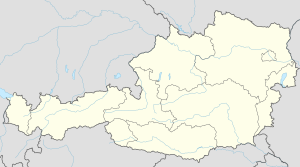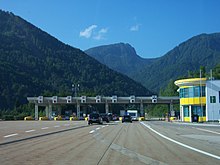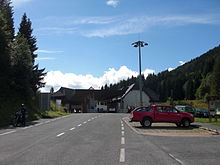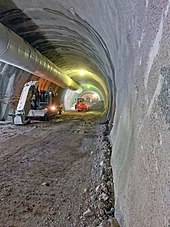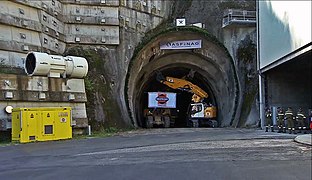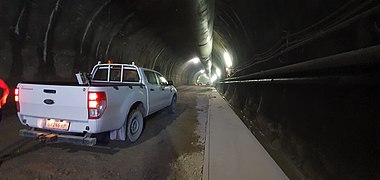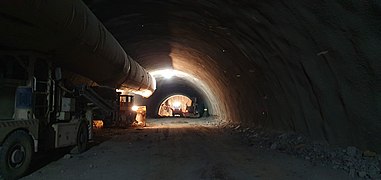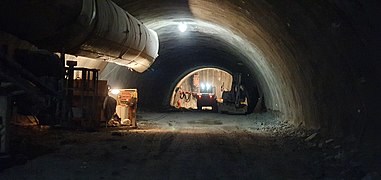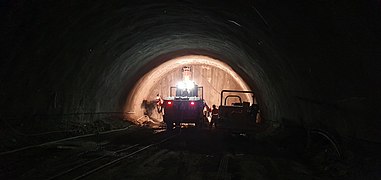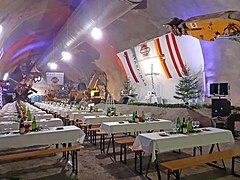Karawanken tunnel (motorway)
|
|
||
|---|---|---|
| use | Road tunnel | |
| traffic connection |
|
|
| place | Karawanken | |
| length |
West tube : 7864 m east tunnel (under construction): 7948 m |
|
| vehicles per day | Ø 10,859 (2017) | |
| Number of tubes | one (second tube in the construction phase) | |
| cross-section | 89 m² | |
| Largest coverage | 1100 m | |
| construction | ||
| Client |
Western tube : ( Austria ) Tauernautobahn AG ( Slovenia ) until 1989 Skupnost za ceste Slovenije , from 1990 Republiška uprava za ceste Eastern tube : ASFINAG / DARS |
|
| building-costs |
West tube: ATS 2.2 billion East tube: 340 million euros |
|
| start of building |
West tube : August 12, 1986 East tube : September 18, 2018 |
|
| completion |
West tube : June 1, 1991 East tube : February 2024 Total completion : early 2026 |
|
| planner |
West tube : (transnational) Motor-Columbus , ( Austria ) Tauernautobahn AG , ( Slovenia ) Geoconsult / GeoZS East tube : ( Austria ) Laabmayr & Partner , iC consulenten , IGT Geotechnik & Tunnelbau , ( Slovenia ) JV ELEA iC , IRGO Consulting , IBE , LINEAL , PNZ , Geoportal , IGH |
|
| business | ||
| operator |
|
|
| toll |
2020 : Car : 7.50 EUR Truck: See go-maut.at |
|
| map | ||
 The Karawanken tunnel connects the federal state of Carinthia with the Slovenian region of Upper Carniola .
|
||
| location | ||
|
|
||
| Coordinates | ||
| South portal | 46 ° 27 ′ 12 ″ N , 13 ° 59 ′ 25 ″ E | |
| North portal | 46 ° 31 '11 " N , 14 ° 1' 23" E | |
The Karawanken Tunnel ( Slov .: Predor Karavanke ) is an almost 8 km long border tunnel between Austria and Slovenia . Built between 1986 and 1991, it connects the Austrian Karawanken motorway with the Slovenian Avtocesta A2 in the direction of Ljubljana between Jesenice and Rosenbach, a district of Sankt Jakob im Rosental . It runs through the eponymous Karawanken ( Karavanke in Slovenian ), a mountain range of the southern Limestone Alps . The travel time from Villach to Ljubljana has been reduced by over an hour since the opening of the 7,864 meter long tunnel. A second tube has been under construction since 2018 and should be completed in 2024.
history
The construction, maintenance and financing of the approximately 9.8 km long Karawanken motorway tunnel stretch, running from Winkl im Rosental, Carinthia, to Hrusica in Oberkrain, Slovenia, was decided on June 29, 1978 with Federal Law Gazette No. 442 and with the decree of The then Federal Ministry for Buildings and Technology on January 24, 1979, including the planning, was transferred to Tauernautobahn AG .
At the beginning there were still considerations to build the tunnel with two tubes from the outset, but at that time the volume of traffic was expected to be too low, which in retrospect seems logical, since there were hardly any motorways in Slovenia or Yugoslavia compared to today in general, unlike in Austria. Nevertheless, one expected a later full expansion. On the Austrian side, the then prefabricated tunnel profile for a future eastern tube could be seen until 2018, which reached about ten meters into the mountain, similar to e.g. E.g .: at the Tauern tunnel or the Katschberg tunnel , where prefabricated front portals for a second tunnel were also built during the construction of the first tubes and left until they were fully completed. Those who drive through the tunnel have always been able to see the numerous side exits and exits on the east wall of the tunnel, the so - called cross passages , which, however, will not be connected until they are fully completed and are currently being gradually connected to the progress of the driving work in the new east tube . The entire ventilation system, which includes two ventilation shafts several hundred meters high and protruding to the surface of the mountain, was built from the outset for two tubes and is now waiting to be connected to the east tube.
A state treaty between Slovenia and Austria was signed as early as 1977, which was amended and re-signed in 1983 due to Yugoslavia's financing problems. In 1985, Yugoslavia received funding from the European Investment Bank . In 1986 and -87 the project was advertised in both countries.
The construction of the west tube of the Karawanken tunnel began with the tunnel in Slovenia in August 1986 and in Austria in June 1987. The historic tunnel breakthrough took place on May 28, 1989. The opening was celebrated on May 31, 1991. It was opened to traffic on June 1st. The construction work was carried out for Austria by Swietelsky , for Slovenia by the now dissolved Slovenija ceste Tehnika , the German construction company Polensky & Zöllner , which also went bankrupt in 1987 , as well as the Slovenian construction company Gradis BP and the Italian Delma Srl. The Karawanken Autobahn was initially commissioned with one lane in June 1991 and completed in June 1992. Tauernautobahn AG invested a total of 3.3 billion Austrian Schillings in 4.4 kilometers of tunnels and 16.8 kilometers of open-air route (approx. 240 million Euro). The tunnel itself cost 2.2 billion schillings, of which Austria took over 1.2 billion and Slovenia the equivalent of one billion. Four men lost their lives in the construction of the tunnel, three of them were Carinthians. Already 27 days after it was opened, the tunnel was briefly occupied by units of the Yugoslav People's Army during the Slovenian 10-day war in June 1991 , but was taken again by Slovenian units on June 30th.
The client was Tauernautobahn AG for Austria , Skupnost za ceste Slovenije for Slovenia until 1989 and Republiška uprava za ceste from 1990 . According to the agreement of December 15, 1987, the state of Carinthia (Office of the Carinthian Provincial Government) was entrusted with building supervision for Austria. Until the opening of the tunnel, Yugoslavia could only be reached from the northwest via mountain passes ( Wurzenpass and Loiblpass ) or through the railway Karawanken tunnel .
Before Slovenia joined the Schengen area, the Austrian border police station was in Rosenbach, municipality of St. Jakob im Rosental .
When it opened in 1991, the Karawanken Tunnel was the ninth longest tunnel in the Alps and 16th place among the longest tunnels in the world . To date, it is the longest tunnel in Slovenia, albeit the only motorway tunnel with only one tube. With the front portals, it measures 8,019 meters and ranks fourth among the longest road tunnels in Austria . For the first tube, 301,000 cubic meters of rock were broken out of the mountain, 274 tons of explosives were used and 1,056 tons of reinforcing steel were installed. 1,575 cubic meters of concrete were used for the tunnel vault alone.
Technical information
Dimensions
From the west tube, 3,450 meters are on Slovenian and 4,414 meters on Austrian territory. The north portal is 655.30 m above sea level. A. , the apex at 673.61 m above sea level. A. and the south portal at 620.68 m above sea level. A. The tunnel gradient, ie the gradient, is + 0.5% from the north portal to the apex at 3.88 kilometers and falls from there to the south portal by - 1.35%. The highest overburden of the tunnel is 1100 m.
profile
The tunnel profile has a circular cross-section. The clearance profile measures 4.7 m high with a roadway width of 7.5 m or 2 × 3.75 m, as well as pavements 1 meter wide, raised on both sides. The full section is not inverted arch 89 m² and m² with invert arch 100th The ventilation cross-sections or the ventilation systems run above the driving area in the tunnel's calotte, which is delimited by a false ceiling . This is divided into a supply air duct (Ø 10 m²) and an exhaust air duct (Ø 8 m²) by a partition in the middle.
Ventilation system
The tunnel has a so-called cross ventilation , consisting of four ventilation sections, four ventilation centers, two of which are portal centers i.e. the ventilation centers at the north and south portal of the tunnel, which serve the two outer ventilation sections, as well as two cavern centers below the ventilation shafts in the mountain, which supply the two inner ventilation sections. Four supply air fans with a total output of 2000 kW and a total air volume of 790 m 3 / s provide ventilation and four exhaust air fans with a total output of 1500 kW and 630 m 3 / s ensure air extraction. Calculated from the tunnel length and cross-section, there is approximately 700,000 m 3 of available air volume in the entire tunnel. This can be completely replaced every quarter of an hour when the system is at full capacity. The supply air enters the driving area above the east wall of the tunnel through 27 × 42 cm ventilation slots at a distance of seven meters. The exhaust air, on the other hand, is extracted at a distance of 14 meters through 35 × 80 cm openings located above the western side of the road.
Ventilation shafts
The two ventilation shafts, of which there is one on each side of the country, should also ensure a quick exchange of air deep in the tunnel. The shafts, which are installed in the mountains, run from the surface of the mountain vertically down to the tunnel, which means that the moving air has to travel a shorter distance from and to the two inner ventilation sections than if it would flow through the tunnel portals. At the same time, the additional ducts can significantly increase the volume of incoming and outgoing air. At the height of the tunnel, the shafts open into so-called cavern centers , which are located next to the actual tunnel and are connected to it at the side.
The southern ventilation shaft is located at tunnel km 5,766 and is 570 meters high. The practically identical north shaft is just under ⅔ lower at 202 meters and is relatively close to the north portal, which is why it has an underground connection running parallel to the tunnel, which only connects deeper inside the mountain to the northern cavern center. At the upper end of the two shafts there is a hall, a so-called shaft head , for snow-free air intake with a 30 m high exhaust air chimney, a winch chamber with an operating winch and an emergency winch, which is used for maneuvering during inspections and maintenance work. The shaft has a clear diameter of 5 m, the excavation is 25–30 m² depending on the depth and the rock. In order to avoid water ingress and freezing in the supply air duct, a corresponding surface seal was installed between the outer and inner ring of the shaft. The inner ring is connected to the outer ring every 12 m. In the inner ring itself there is a partition which divides the ventilation shaft into a 10.2 m² supply air duct and an 8.1 m² exhaust air duct. Vertical pipes and horizontal half-shells ensure drainage.
Cavern headquarters
The cavern centers were built for two tunnels from the start. In relation to the model of the fully developed tunnel, these are located between the tunnel tubes 70 meters apart, i.e. 35 meters east of the older western tube. In order to be able to control the pressurized mountain conditions, instead of a single central cavern, a supply air and an exhaust air cavern were constructed under the southern ventilation shaft, which have a smaller span , unlike the north shaft, which only thanks to the stable rock on the Austrian side consists of a single cavern with an excavated cross-section of 287 m², excluding the base vault. The excavated cross-section of the southern caverns with the base vault is 170 m² with a span of 14 meters. A part of the caverns is already connected to the east tube from the beginning in such a way that there is a separate area for vehicles to turn around. At the level of the road there are transformers , high-voltage rooms and battery rooms for emergency power supply, as well as a shelter, an emergency call and fire extinguishing niche. The control centers are two-storey, with the fan, high and low current rooms, as well as fan control cabinets and tunnels connected to the shaft for ventilation, on the upper floor . An access tunnel leads to the exhaust air cavern below the supply air tunnel to the shaft.
Supply and exhaust air are regulated separately in normal operation, with the supply air being determined on the basis of the CO concentration or the clouding of visibility and the exhaust air being determined according to the air speed in the tunnel itself. The limit value for carbon monoxide is 250 ppm and the minimum stopping visual range is 100 meters. The maximum permissible air speed in the tunnel is 8 m / s.
power supply
The west tube currently consumes 5600 kVA . The electricity for this is supplied from the 20 kV networks of the Carinthian electricity company KELAG , and in Slovenia from the network of Elektro Gorenjska . If one network fails, the other can take over the work alone. In the tunnel, lights are mounted on the ceiling every 12 meters, at the beginning still sodium vapor lamps , later LED lamps .
geology

overview
The Karawanken tunnel essentially crosses formations of the Werfen strata , dolomites and limestone of the Triassic as well as slate , conglomerates and sandstones of the Hochwipfelflysch . The mountain range is severely fragmented lengthways and transversely due to recent fracture tectonics . There are vertical displacement amounts of several hundred meters. The southern section of Slovenia, which is particularly heavily stressed tectonically, has strongly changing conditions, including long stretches in difficult geology .
Historical challenges
In the historical construction documentation of the nearby railway tunnel (1901–1906) it was already stated that the deformation of the tunnel caused by the movement of the mountains meant that a drill rig stopped moving through it just four hours after a new section was opened because he had been trapped by the mountains. The ridge vault at that time consisted of massive stone blocks, which were so badly damaged by the mountain pressure that the railway tunnel had to be reconstructed over a distance of five hundred meters.
Obstacles in the construction of the first tunnel tube
In the construction of the west tube from 1986 onwards, there were many problems, primarily on the Slovenian side, which were already known from the construction of the railway tunnel. After 700 meters of tunneling from the south side there was already a water ingress of 100 liters per second, which led to a one-month construction stop. When the shotcrete shell was being erected, the rock movements caused a diagonal crack across the entire tunnel. Serious damage to the shotcrete and anchors was the result. This resulted in a dome convergence , i.e. the dome was pushed in or narrowed by rock movements by up to 1.5 meters from the original starting point. This led to shear cracks and speeds of convergence (speed of rock deformation) of 25 cm per day. Even after the excavated sections settled down for several months, they suddenly jerked up to 45 cm from the tunnel's initial profile. The so-called oversize of the tunnel profile was then changed, so that even after convergences of 70–80 cm, the shotcrete shell could still remain undamaged.
As a result of these long-lasting and often delayed movements, post-anchoring areas had to be defined over a year after the actual shotcrete shell had been erected, with individual sections already being a hundred meters long. Up to three different anchor grids were used here. From a general point of view, the anchoring scheme in the Karawanken tunnel referred to excavation class 6 of 7, which requires an advance securing, i.e. securing the area to be excavated in the future with anchors before it is opened. 10–12 anchors with a length of 9 meters or six anchors with a length of 6 meters and an adhesion of approx. 250 kilonewtons (kN) were used in the dome . On particularly unstable sections in the overall profile, up to 600 meters of anchors were required per tunnel meter. A special construction of a flexible anchor head developed by the construction company Alpine Mayreder, Kraus & Co. was used. This was flexible and was able to compensate for the movements of the mountains up to 20 cm without tearing.
The biggest obstacle in the construction of the Karawanken tunnel arose after driving 3,000 meters from the south, with a devastating water ingress of several hundred liters per second, which flooded the tunnel one meter high and flushed 4,000 cubic meters of rock into the tunnel. Most of the equipment was washed away and badly damaged, but no people were harmed by proactive action in the knowledge of the impending water ingress. The pressure of the mountain water was up to 3.5 megapascals , in some drainage outlets up to 70 bar . A separate temporary tunnel had to be built in this area parallel to the road tunnel in order to get to the northern side of the collapse zone and to be able to drill anchor holes. The construction work was delayed by 2 months for this alone.
Situation in the east tunnel
In contrast to the construction of the first tunnel tube, the new east tube has the great advantage that the geology in the area of the tunnel is well developed, which prevents surprises and the timing for particularly difficult sections can be precisely prepared. In addition to the existing documents from the construction of the first tube, test drillings were carried out along the west tube towards the east tube in 2015 and 2016. This repeatedly led to the release of trapped mine gases , which led to traffic obstructions.
The tunneling work that is now under way on the Austrian side of the new eastern tube has shown that the rock conditions in the area of the second tube are even better than originally assumed. As a result, significantly higher advance rates are possible in some areas than planned.
toll
A special toll must be paid for the tunnel . The reason for this are the high costs of now over half a billion euros, which flow into the original construction, the current full expansion and the maintenance and maintenance of the tunnel system.
The amount for the car toll with and without a trailer is around 7.50 euros in 2020 and can be paid in cash or by credit card (VISA / Mastercard). In addition, you can book the digital route toll (formerly known as the “video toll”) online by specifying the license plate number, so that the toll is not paid on site. However, this option is only available in the south, in the north you have to pay locally. The reason for the difference are different operators.
For frequent drivers there is the option of purchasing a license plate-bound 14-trip monthly pass. In 2020 it costs around 33.60 euros, is valid for 14 journeys and is valid for 30 calendar days from the date of issue. Unused trips expire.
Because of the special toll route, the Karawanken tunnel can be used from St. Jakob without an Austrian vignette. According to Asfinag, the route can be used without a Slovenian vignette up to the Hrušica exit.
Alternative routes
Especially in the event of a traffic jam in front of the tunnel, there are several alternative routes available from a delay time of one hour, which can also be covered in around an hour.
The following alternative routes start from the center of the tunnel within a radius of 40 kilometers and lead to and from the Villach motorway junction or to Jesenice and the surrounding area.
Via pass roads :
- The Seebergsattel is 40 km east of the Karawanken tunnel. It has a gradient of 12% and is suitable for caravans and can be used all year round. This can be reached from Slovenia by exiting the Avtocesta A2 at the Kranj Ost motorway junction and taking the Slovenian national road 210 in the direction of Eisenkappel-Vellach . On the Austrian side, continue on the B 82 Seeberg Strasse into the valley and from there take the B 85 Roßental Strasse along the Karawanken in a westerly direction to Sankt Jakob im Rosental (at the north portal of the Karawankentunnel). Alternatively, instead of driving west on the B 85, you can also drive north on the B 91 Loiblpass Straße towards Klagenfurt and from there on the south autobahn A2 back towards Villach .
- The Wurzenpass 20 km west of the tunnel. Accessible all year round. 18% incline. ÖAMTC wording : "Great caution and mountain experience necessary, unsuitable for campers, prohibited for combinations. (Trailer ban applies in both directions for all types of trailers)."
- The Loiblpass 20 km east of the tunnel. 17% incline. Accessible all year round. ÖAMTC wording : "Forbidden for trailers, forbidden for trailers over 750 kg and trucks. Peak tunnel : 1,566 m long."
Via federal road and motorway :
- The border triangle 30 km west of the Karawanken tunnel which leads from Austria over a short distance through Italy to Slovenia and is located in the Carinthian town of Thörl-Maglern . This can be done between Austria and Italy via the A2 Südautobahn / Autostrada 23 as well as the parallel federal road B83 Kärnter Straße / Strada Statale 13 and then between Italy and Slovenia exclusively on the Italian federal road Strada Statale 54 and in Slovenia on the federal road 201 / 202 in the direction of Jesenice .
Usage frequency
In June / July / August 2016, 160,000 / 322,000 / 303,000 vehicles were counted in the direction of Slovenia alone. In total, almost 800,000 vehicles in three months. In July 2015 there were still 265,000 vehicles.
Outside the travel time, around 10,000 vehicles per day can be counted as of 2020, and more than 30,000 per day in the summer months.
Traffic jams occur regularly, especially on Saturdays and Sundays. On the eight Saturdays in July and August 2016, Asfinag distributed a total of 106,000 half-liter plastic bottles of mineral water and 20,000 coloring books plus crayons for children to the people in traffic jams.
Traffic broadcast
The transmitters Ö3 ( Austrian radio , 90.4 MHz) and VAL 202 ( Radio Televizija Slovenija , 98.9 MHz) can be received in the tunnel .
Tunnel safety
In the two-way tunnel, a reduced speed limit of 80 km / h will apply until operation with two tubes from 2026. When there is heavy traffic, the speed is reduced to 50 km / h. The lanes are separated by a double barrier line. Overtaking in the tunnel is not allowed and is severely punished. For example, in August 2020 a German driver had to pay a fine of 700 euros after overtaking two vehicles in the tunnel on the way to Slovenia.
The monitoring of the tunnel is shared by both countries; it changes monthly between the traffic control centers in Klagenfurt , Carinthia (formerly in Zauchen) and Hrušica in Slovenia.
ASFINAG provides its own fire protection unit called the Karawankentunnel fire protection group , which is stationed at the Austrian toll station and can intervene immediately in conjunction with the St. Jakob and Rosegg volunteer fire departments should an alarm be triggered in the tunnel. The fire protection group is on standby during the week, while the above-mentioned fire brigades are on call at night and on weekends. When deployed, other fire brigades from the surrounding cadastral communities of Sankt Jakob im Rosental can be called in quickly, namely the Maria Elend volunteer fire brigade and the Frießnitz Rosenbach volunteer fire brigade, both of which are stationed less than five kilometers from the north portal. Further support comes from the main fire station in Villach and the Dolintschach volunteer fire department. In Slovenia there is a company fire brigade right next to the south portal of the tunnel , which is supported during operations by the fire brigade of the city of Jesenice . All of the fire brigades mentioned were used in February 2020, for example, when a car caught fire in the tunnel with heavy smoke. Nobody got hurt. The tunnel could be reopened after just two hours. The speed of the on-site unit was e.g. This was also demonstrated in 2012, for example, when an overheated tire on a truck began to burn immediately after exiting the north portal of the tunnel. The burning tire was discovered and extinguished immediately before it could spread to the rest of the vehicle. The fire brigades also have a special fire engine, which was converted for use in tunnels at the expense of ASFINAG. Regular training courses for the transnational emergency services are an integral part of the safety concept, including large-scale exercises with hundreds of participants.
The currently single-tube tunnel currently has 5 redundant tunnel control units and servers, 48 emergency call devices in the tunnel, 24 traffic lights, 18 electronic information boards and 20,000 system data points. In 2013 the entire control system and parts of the electrical machine equipment were adapted to the state of the art and renewed.
In May 2012, a thermal portal was put into operation at the Austrian border station , which uses five 3D laser scanners and two infrared cameras to detect hot brakes on trucks and buses over 7.5 tons and prevents the affected vehicles from entering the tunnel by means of a traffic light switch to avoid possible fire to prevent. In the first year around 300 trucks and buses were therefore stopped. The thermal portal with technology from Sick was the first such system in Europe and was built by ASFINAG to promote safety - without a statutory mandate . A jury for the topic of dangerous goods transport awarded the facility the German Innovation Prize.
In autumn 2013, an event detection was retrofitted for the video system, which is supposed to detect rising smoke or traffic jams early and sound the alarm in good time.
In 2014 the ventilation system was renewed for 7.5 million euros, which significantly improved the air quality in the tunnel, so that driving bans for heavy vehicles due to poor air are no longer necessary today. When driving through the tunnel, in contrast to earlier times, you can see a continuous false ceiling behind which the ventilation system is hidden. This tunnel ceiling and the associated cross ventilation did not previously exist in the middle of the tunnel. Instead, fans with a high noise level provided so-called longitudinal ventilation .
In order to be able to better control the number of heavy vehicles over 7.5 tons in the tunnel in heavy traffic, there is a metering system in Slovenia and Austria which ensures that a maximum of 6 trucks or buses can be in each direction of travel in the tunnel at the same time. There is therefore a minimum interval of one minute between heavy vehicles over 7.5 tons.
Full expansion and general renovation 2018–2026
Last stand
As of early June 2020, more than 2,600 meters had been driven in Austria . That is more than half of the Austrian part, which is 4,402 meters long. Since the end of July 2020, the final internal formwork has been concreted here with the help of a tunnel formwork carriage. At 3,546 meters, the Slovenian part is 20% shorter than the Austrian route.
In Slovenia, the excavation of the tunnel began on August 26, 2020 . Since then, 120 to 150 workers including management have been working on the south portal. This was preceded by several months of preparatory work, which began in March 2020. The original start of tunneling work for Slovenia and Austria would have been September 18, 2018. This was delayed for Slovenia by almost two years due to problems with the tender for a contractor .
initial situation
In 2004, the European Parliament passed a directive entitled “Minimum requirements for the safety of tunnels in the trans-European road network” (Directive 2004/54 / EC) , which meant that an escape tunnel had to be built by 2019 for the Karawanken tunnel in particular . For this reason, a study was commissioned in 2006 to examine whether it would make sense to build a second tube instead of a simple escape tunnel. After evaluating this study, ASFINAG announced the full two-tube expansion in March 2015.
Bridge construction at the north portal
As an advance payment, a 350-meter-long motorway bridge to the new east portal was built on the Austrian side from September 2015 to October 2017, as well as a 14-meter-high retaining wall for the slope reinforcement. The completed bridge was then connected to the existing motorway in the direction of the toll station by building a 250 meter long connection.
Project details
For Austria, the selection went to Swietelsky Tunnelbau GmbH, selected from seven offers, with a bid of 89.9 million euros without objections from other providers , which had also built the first tunnel for Austria.
The project was funded by the European Union as part of the Connecting Europe Facility (CEF) program in the planning phase with 3.35 million euros. There is a signed subsidy contract for the construction phase with a maximum subsidy of 9.4 million euros. DARS received a loan agreement in the amount of 90 million euros from the European Investment Bank (EIB), ASFINAG one in the amount of 95 million euros. These amounts are backed by the European Fund for Strategic Investments (EFSI). Since the tunnel is part of the trans-European transport network (TEN), there is a particular interest on the part of the EU in promoting the project. Half of the loan will be used for the new east tube, the other half for the renovation of the old west tube.
On September 18, 2018, the celebratory tunnel construction took place at the north portal in Austria. Since then, driving on the Austrian side of the tunnel has taken place at a rate of 7 days a week and 24 hours a day. This in 3 shifts of 8 hours each. The work is only interrupted at Easter and Christmas. In the dome , between 5 and 6 cuts (blasts) are carried out per working day. Depending on the depth of the tee, this corresponds to an average of around 7 meters per day. The previous maximum propulsion power is as at August 2019 10 meters per day after completion of work on the dome is the bench , also with 5 to 6 tees per day, but with double tee depth, that is about 14 meters per day ascended . The sole is then tightened at a speed of 15 to 20 meters per day.
The preparatory work in Slovenia started after a delay of a good one and a half years in the first week of March 2020. The contractor for Slovenia, Cengiz İnşaat , has 62 months to complete the work. From March to August, work was carried out on the site around the south portal, such as fortification work on the mountain slope, the construction of a concrete plant, a workers' settlement, etc. In the course of this, a few hundred square meters of trees above and east of the tunnel portal were cut down.
The tunnel breakthrough on the border between Austria and Slovenia is scheduled for mid-2022. The subsequent interior work with the construction of the tunnel inner shell should be completed by the beginning of 2023, after which the equipment with safety devices will follow by February 2024 and then the approval of the new east tube.
For the renovation of the old west tube from the beginning of 2024, a separate tender will be carried out again.
The construction of the new east tube is based on the New Austrian Tunneling Method . The total length of the tunnel is 7,948 meters, of which 4,402 meters in Austria and 3,546 meters in Slovenia. The tunneling should be completed in Austria by the end of 2021 and in Slovenia by the middle of 2022. By then, a total of around 2.6 million tons, that is more than 90,000 truck loads, of rock will have been excavated on both sides. The construction will take up to half a million tons of concrete.
The new Building Information Modeling (BIM) is also used in the construction of the Karawanken Tunnel . This represents the entire structure in a digital 3D model.
According to ASFINAG, the total costs for Austria, i.e. the costs for the planning, construction and transport connection of the new east tube including all associated structural measures and the renovation of the existing tube, will amount to approx. 192 million euros for Austria (168 million for the tunnel itself) for Slovenia, the costs will amount to around 150 million euros, according to the operating company DARS . The pure costs for the new tunnel construction will amount to 320 million euros for ASFINAG and DARS.
Rehabilitation of the west tube
After completion of the new east tube in February 2024, the existing west tube will be closed immediately afterwards , as was the case a few years ago when the Katschberg and Tauern tunnels were fully expanded and renovated for almost 2 years. Due to the comparatively poor condition of the tunnel on the Slovenian side, the renovation work will be particularly extensive and therefore take a lot of time. All two tunnels should go into full operation at the beginning of 2026.
In terms of traffic technology, only the existing tube or, during the renovation, only the new east tube will be passable until the total opening of both tunnels at the beginning of 2026, so that there is still oncoming traffic in the tunnel and a permanent speed limit applies.
Technical innovations
Since there were no escape routes before the construction of the new eastern tube, the construction of the same brings central safety-related innovations, in particular 26 accessible cross-passages, which will connect both tubes approximately every 350 meters, as well as 8 passable cross-passages. These cross passages are being built parallel to the tunneling work in order to be able to provide new escape routes as quickly as possible.
When the first tube was built, the ventilation system was designed for full expansion with two tubes, which is why no new ventilation shafts or cavern centers etc. have to be constructed. The new tube only has to be connected to the existing system from 1991, which lies between the two tubes.
In the course of the construction work, the north portal in Austria is to receive a new facade in a contemporary design. The ausgelobten contest to win the architectural firm Hertl of Steyr with a design consisting of a curtain, transparent aluminum construction.
In Slovenia, the tunnel will have a 100-meter-long gallery in the same design as the old tube, a new underground collection of mountain water and two drainage pipes in the southern portal area. In addition to the actual tunnel construction, the motorway between the south portal of the tunnel and the toll station in Hrušica will be simultaneously extended to four lanes over a length of 620 meters, so that in future two separate bridges will lead to the respective tunnel portals.
In the first phase, the actual tunnel and the internal circuit are produced, in the second phase the tunnel electronics are installed. The electrical installation will be carried out jointly by a single company for Austria and Slovenia.
After completion of all construction work at the beginning of 2026, the Karawanken tunnel will have a new type of median crossing control system (MÜLS). In the event of a malfunction (e.g. in the event of an accident), it can automatically control movable concrete guide walls in front of the tunnel portals and thus divert the lanes and the traffic on them into one or the other tube and at the same time switch them to two-way traffic. This means that if the worst comes to the worst, the entire traffic routing through the tunnel can be changed within a very short time.
Before the completion of the new eastern tube in 2024, the Villach motorway junction is also to be structurally adapted in 2023 . This connects the Karawanken Autobahn with the A2 and A10 , but only with one lane in each direction. Appropriate measures are being planned here so that the flow of traffic is not hindered in the future.
During the construction of the new east tube, the Swietelsky company, together with SKIDATA , is testing a person recognition system that will track the number of workers in the tunnel in real time. The reason for this is a new regulation of the Austrian Labor Inspectorate , according to which z. B. In the event of a fire, it must be ensured that everyone has left the tunnel.
Award dispute and allegations of corruption in Slovenia
First contract between DARS and Cengiz İnşaat
After the start of the tender for a designer for Slovenia in December 2017, DARS would have commissioned a major global corporation from Turkey, Cengiz İnşaat , with a bid of 89.3 million euros at the end of July 2018 . Although the offer complied with EU standards and was reasonably priced, especially in relation to the Austrian side, which has 900 meters more tunnel and costs 89.9 million euros, the losers in the award complained in August, including the Slovenian companies Kolektor CPG from Nova Gorica and Gorenjska Gradbena from Upper Carniola about the award to a foreign company and tried to publicly discredit the Turkish company with allegations of price dumping.
First objection by competitors
After the complaints were rejected by DARS, the complainants called the national review commission DKOM, which canceled the award at the end of November 2018 because of "inadmissible documents". It is noticeable that these were purely formalities without significant influence on the written offer, which were proven to be present in all offers, including those of the Slovenian plaintiffs, and in general could hardly have been avoided. Some observers saw an attempt by local companies to intrigue against the foreign tender winner or against DARS itself. There was also public and not for the first time speculation about corruption incidents at DKOM, which is why the Slovenian Ministry of Public Administration recently passed its own law to protect the independence of DKOM
The offers from the Slovenian companies would have been significantly higher, between 15 and 20 million euros, and would have brought in important income for the rather small companies, which would probably have been less important for the large group Cengiz. At the same time, none of the Slovenian complainants has the expertise or the resources for such a project, which is why they had to set up special consortia with foreign companies to draw up offers.
As a global corporation, Cengiz İnşaat , on the other hand, has already built hundreds of kilometers of rail and road tunnels on its own in addition to projects it has taken over worldwide with a value of USD 24 billion. After evaluating the situation, the DARS center was in February 2019 known to terminate the original contract award procedure and the offers of all applicants for the said formal inadmissibilities in all offers rejected - to protect themselves from similar appeals for formalities - and a so-called negotiated procedure convene to which six selected providers should be invited, including Cengiz İnşaat .
Second objection
The two-week objection period ended on February 28. Again objections were received by the original complainants from Slovenia, Kolektor CPG and Gorenjska Gradbena , who in their own opinion should receive the contract, against the now new selection procedure. Only two weeks later, the DARS again rejected the objections, which means that the proceedings have now been passed on to the DKOM again.
During the renewed discussion of the objections at the DKOM at the beginning of April 2019, Borut Smrdel , who has been chairman of the state review commission since 2012, surprisingly announced his resignation and justified this by saying that there would be repeated attempts from outside to exert pressure on the DKOM in order to make its decisions to influence and referred specifically to the current award dispute over the Karawanken tunnel. The influence would go so far that decisions would no longer be made "on the basis of the law".
On May 15, 2019, DKOM's judgment was published, according to which the Commission had rejected the objections of Kolektor CPG and Gorenjska Gradbena . The DARS started the negotiation process with six applicants and their partners late . After an extension of the deadline, offers could be submitted until July 25th.
Third objection
On June 26, Gorenjska Gradbena and Kolektor CPG lodged a complaint with DARS against the participation of Cengiz İnşaat for the third time in a row , on the grounds that the company did not qualify for participation. DARS forwarded the case directly to DKOM. A decision by DKOM was expected in mid-September 2019.
On July 25, DARS surprisingly announced that DKOM had dealt with the third objection in a fast-track procedure and had already rejected it again on a three-page paper in favor of DARS in mid-July. Five offers from the concluded negotiation process were officially published by DARS in July. After almost two months of evaluating the new offers, DARS announced on September 18 that three of the five providers could bid for a final contract.
In August, a democratic member of the Slovenian parliament, Žan Mahnič, caused a curiosity in a letter to the government, suggesting that the Austrian construction company Swietelsky should simply drill through to Slovenia, as this would be faster and cheaper than going further to one to look for our own designer for Slovenia. This slightly ironic suggestion should, however, be taken seriously and, in addition to monetary and temporal factors, be justified by the fact that the public procurement system in Slovenia is regularly misused to postpone projects for several years or illegally with the help of corrupt machinations around the DKOM to be given to local companies.
During a discussion of the parliamentary commission for financial control in Slovenia on September 4th, the chairman of the DARS, Tomaž Vidic, informed about the state of the developments. According to Vidic, the proposal to drill the tunnel exclusively from the Austrian side as far as Slovenia is not possible from a legal and technical point of view. However, he did not give any details.
Fourth objection
At the beginning of October 2019, Gorenjska Gradbena and Kolektor CPG filed for the fourth time against the final bidders chosen by DARS, including Cengiz. The DARS again rejected the new objections in mid-October and passed them on to the DKOM. DKOM decided in mid-November to also reject the objections.
Renewed award to Cengiz İnşaat
On Tuesday, December 3, 2019, after brief negotiations with three companies, namely the Slovenian Kolektor, the Austrian-Swiss Implenia, and the Turkish Cengiz, the Slovenian DARS decided on the contract, which is now worth 98.5 million euros (excluding tax ) to give again to Cengiz İnşaat .
The Turkish provider reduced its offer in the first round of negotiations by one million euros from the original 99.6 million euros. The Kolektor CPG consortium reduced its offer from almost 121 million to around 104 million euros. The consortium of the Austrian Implenia reduced its offer from 121.5 million to 115 million euros.
Since neither the Kolektor nor Implenia consortium was able to undercut the Turkish company Cengiz after the first round of negotiations , the remaining 3 rounds of negotiations were canceled and the decision was made after less than an hour.
The CEO of Cengiz İnşaat , Utku Gök , said on Monday before the negotiations that the construction in Slovenia would still be finished on time with his company.
The objection period expired on December 13, 2019 without further objections. Contrary to what the DARS assumed, which expected a fifth objection from Kolektor . Kolektor CPG announced on December 5th that it no longer wanted to object to the new award to Cengiz İnşaat .
On December 20, 2019, the DARS Supervisory Board officially accepted the appointment of Cengiz İnşaat .
consequences
The repeated objections of the same companies over and over again sparked a great debate about the public procurement system in the country. Now consequences are to follow. In order to prevent repeated objections to public awards in the future, objections should only be made once. The DKOM is also to be rebuilt, so there were demonstrably politically linked commissioners. The committee is to become more independent in the future, but at the same time be given more authority.
In December 2019, the Slovenian Ministry of Infrastructure, together with the ÖBB , decided that the award for the renovation of the Karawanken railway tunnel , which is due to start in October 2020, should only be carried out under Austrian law, so that a situation like that of the motorway tunnel should no longer occur.
Pictures from the construction site
See also
Web links
- Carinthia today, May 21, 2020 "Karawanken Tunnel: Carinthia on schedule"
- A 11 Karawanken Autobahn - new construction of the second tube Karawanken tunnel (project description by ASFiNAG)
- Video about the thermal portal
- Short documentation on the construction of the Karawanken tunnel (Slovenian with English subtitles)
- Video animation of the future south portal in Slovenia
- Blast at the tunnel attack in Austria on September 18, 2018
- Carinthia today from September 18, 2018 - Karawanken tunnel in Austria
- Recordings of the tunneling work in February 2019
- Start of the first cross passage construction on March 11, 2019
- Pictures of the construction site from August 2019
Individual evidence
- ↑ https://www.asfinag.at/ueber-uns/newsroom/pressemmeldung/2018/tunnelanschlag-vollausbau-karawankentunnel/
- ↑ Permanent counting stations - traffic statistics 2017 ( Memento from March 25, 2018 in the Internet Archive ) (ZIP; 2.4 MB). In: asfinag.at , accessed on March 24, 2018.
- ↑ Archived copy ( memento of the original from August 17, 2018 in the Internet Archive ) Info: The archive link was inserted automatically and has not yet been checked. Please check the original and archive link according to the instructions and then remove this notice.
- ↑ https://www.alptransit-portal.ch/Storages/Dossiers/CH-BAR_E8100C_1999-140_851/CH-BAR_E8100C_1999-140_851_9.pdf?v=1539068703
- ↑ https://www.alptransit-portal.ch/Storages/Dossiers/CH-BAR_E8100C_1999-140_851/CH-BAR_E8100C_1999-140_851_9.pdf?v=1539068703
- ↑ https://www.asfinag.at/verkehrssicherheit/bauen/bauprojekte/a-11-karawanken-autobahn-neubau-zweite-roehre-karawankentunnel/
- ↑ https://www.mein Bezirk.at/land-kaernten/lokales/tunnelsicherheit-im-fokus-asfinag-investiert-heuer-75-millionen-d2033332.html
- ↑ https://www.asfinag.at/verkehrssicherheit/bauen/bauprojekte/a-11-karawanken-autobahn-neubau-zweite-roehre-karawankentunnel/
- ↑ https://www.ots.at/presseaussendung/OTS_20160601_OTS0040/asfinag-karawankentunnel-ist-seit-25-jahren-oesterreichs-tor-zum-sueden
- ↑ https://www.alptransit-portal.ch/Storages/Dossiers/CH-BAR_E8100C_1999-140_851/CH-BAR_E8100C_1999-140_851_9.pdf?v=1539068703
- ↑ https://www.laabmayr.at/tunnelbau/alpin/karawankentunnel/
- ↑ https://www.asfinag.at/maut-vignette/streckenmaut/tarife/
- ^ Court of Auditors: Audit report of the Court of Auditors. (PDF) Audit Office 1033 Vienna, Dampfschiffstraße 2, October 1996, accessed on November 3, 2018 .
- ↑ https://www.asfinag.at/verkehrssicherheit/bauen/bauprojekte/a-11-karawanken-autobahn-neubau-zweite-roehre-karawankentunnel/
- ↑ bolha.com: Predor Karavanke (39 × 28 mm, sponka). Retrieved October 5, 2019 (Slovenian).
- ↑ ASFINAG: Karawanken tunnel has been Austria's “gateway to the south” for 25 years. Retrieved January 13, 2019 .
- ↑ DARS dd Retrieved October 5, 2019 .
- ↑ Added by @mmcrtvslo Instagram post Predor Karavanke je bil ob izgradnji deveti najdaljši avtocestni predor v Alpah in 16. na svetu. Graditi se je začelo avgusta 1986, za preboj pa je 213 delavcev potrebovalo 1,021 dni in 274 ton eksploziva. Celotna gradnja je trajala pet let in slavnostno so ga odprli 1. junija 1991. V osnovi je bil načrtovan kot dvocevni predor, a je bilo pozneje ugotovljeno, da so prometne zahteve nižje od pričakovanih. Zato je bila sprejeta odločitev, da se najprej zgradi ena cev. Predor je dolg 8,019 metrov z izkopno dolžino 7,864 metrov, od katerih je bilo 3,750 metrov izkopanih na slovenski strani. ? @ fotobobo69 #Karavanke #predor #Slovenija #Avstrija #predorKaravanke #Karawanketunnel #tunnel - Instazu.com. Retrieved October 5, 2019 .
- ↑ https://www.alptransit-portal.ch/Storages/Dossiers/CH-BAR_E8100C_1999-140_851/CH-BAR_E8100C_1999-140_851_9.pdf?v=1539068703
- ↑ Predor Karavanke tunnel GEOLOGIJA in Geotehnika, Ljubljana, 1991, Cestni inženiring po, Ljubljana, Titova 64
- ↑ https://www.ots.at/presseaussendung/OTS_20150210_OTS0060/asfinag-keine-gefahr-nach-gasaustritt-bei-bohrloch-im-karawankentunnel
- ↑ Asfinag special and video toll. In: asfinag.at , accessed on April 5, 2016.
- ↑ Car special toll. ( Memento from July 25, 2008 in the Internet Archive ) In: asfinag.at
- ↑ POI Seebergsattel Austria | ÖAMTC. Retrieved August 24, 2020 .
- ↑ POI Wurzenpass Austria | ÖAMTC. Accessed February 1, 2020 .
- ↑ POI Loiblpass Austria | ÖAMTC. Accessed February 1, 2020 .
- ↑ Karawanken tunnel: The 2nd tube is expected to come in March. January 31, 2020, accessed on February 4, 2020 (Austrian German).
- ↑ The “Asfinag thirst quenchers” were in constant use on Saturdays. ( Memento from August 29, 2016 in the Internet Archive ) In: asfinag.at , August 29, 2016, accessed on August 29, 2016.
- ↑ Record frequency at the Karawanken tunnel. In: orf.at , August 29, 2016, accessed on August 29, 2016.
- ↑ Ujet, ko depending prehiteval v karavanškem predoru. Retrieved August 8, 2020 (Slovenian).
- ↑ Prehitevanje v predoru. Retrieved August 8, 2020 .
- ↑ Karawanken tunnel was closed after a vehicle fire. February 3, 2020, accessed on February 4, 2020 (Austrian German).
- ↑ The car caught fire in the Karawanken tunnel. February 3, 2020, accessed February 4, 2020 .
- ↑ Cross-border rescue exercise. October 8, 2013, accessed February 20, 2019 .
- ↑ Exercise in the Karawanken tunnel. October 16, 2017, accessed February 20, 2019 .
- ↑ https://www.duerr-gruppe.at/de/referenz-da/a11-karawankentunnel.html. Retrieved February 20, 2019 .
- ↑ Europe's most modern thermal portal detects overheated vehicles at the Karawanken tunnel. In: youtube.com
- ↑ Price for the Karawanken tunnel thermal portal. In: orf.at , May 9, 2013, accessed on September 18, 2013.
- ↑ Test for video system in Karawanken tunnel. In: orf.at , September 18, 2013.
- ↑ ASFINAG: Safety package for the Karawanken tunnel. Retrieved November 27, 2019 .
- ↑ Boštjan Fon: Smrt preži v koloni na gorenjski avtocesti (PHOTO). November 26, 2019, accessed November 27, 2019 (sl-si).
- ↑ Svet24.si - PHOTO: Danes stekla prva dela pri izkopu druge cevi avtocestnega predora Karavanke. Retrieved August 27, 2020 (Slovenian).
- ↑ https://twitter.com/dars_si/status/1298633305001164800. Retrieved August 27, 2020 .
- ↑ Turki v težavah. Ali enaka usoda pri nas čaka Kitajce? Retrieved May 13, 2020 (Slovenian).
- ↑ More safety in the Karawanken tunnel. Study on the second tunnel tube. In: kaernten.orf.at
- ↑ Information on the full expansion of the Karanwanken tunnel at www.asfinag.at. ASFINAG press release of March 4, 2015, accessed on March 7, 2015.
- ↑ ASFINAG: awarding the second tube Karawankentunnel to ARGE Swietelsky Tunneling GmbH & Co KG and Swietelsky Baugesellschaft mbH In: OTS.at . ( ots.at [accessed on September 11, 2018]).
- ^ Regionalmedien Austria: Karawanken Tunnel: Construction of the second tube from September . In: mein district.at . ( mein district.at [accessed on September 11, 2018]).
- ↑ 13 03 o'clock, 13 February 2020: Karawanken tunnel: 90 million EU loan to remove "bottlenecks". February 13, 2020, accessed February 13, 2020 .
- ↑ Login - DVZ. Retrieved February 13, 2020 .
- ↑ ASFINAG: Ceremonial tunnel construction as the start of the full expansion of the Karawanken tunnel . In: OTS.at . ( ots.at [accessed on September 13, 2018]).
- ↑ Karawanken tunnel: a construction site of extremes. Retrieved September 9, 2019 .
- ↑ TH: Prva lopata za drugo cev Karavank bo zasajena še ta teden. Retrieved March 3, 2020 .
- ↑ a b c d Ceremonial tunnel construction for the full expansion of the Karawanken tunnel. Retrieved September 19, 2018 .
- ↑ Besedilo: Urša Peternel CATEGORY: Jesenice / sreda, January 15, 2020 / 9:15 am: Gorenjski glas | Cengiz Insaat na obisku pri županu. Retrieved January 15, 2020 .
- ↑ Gradnja predora Karavanke bi lahko bila končana pred rokom. Retrieved January 28, 2020 (Slovenian).
- ↑ Swietelsky builds second Karawanken tunnel tube. In: kaernten.orf.at. August 8, 2018, accessed November 22, 2018 .
- ↑ https://www.kleinezeitung.at/wirtschaft/5477000/Baustart-im-September_90-MillionenAuftrag-fuer-zweite
- ↑ https://www.asfinag.at/verkehrssicherheit/bauen/bauprojekte/a-11-karawanken-autobahn-neubau-zweite-roehre-karawankentunnel/
- ↑ Full expansion of the Karawanken tunnel started on ORF-Kärnten on September 18, 2018, accessed on September 19, 2018.
- ↑ https://www.zurnal24.si/avto/predor-karavanke-druga-cev-cena-cestnina-dars-303608
- ↑ https://sobotainfo.com/sites/default/files/pdf/ac_predor_karavanke_slo.pdf
- ↑ Projects / Functional / Projects - HERTL.ARCHITEKTEN. Retrieved August 22, 2018 .
- ↑ Ceremonial tunnel construction for the full expansion of the Karawanken tunnel. Retrieved September 18, 2018 .
- ↑ http://www.cengiz-insaat.com.tr/?lang=en
- ↑ Nine offers for tunnel construction . March 22, 2018 ( orf.at [accessed October 10, 2018]).
- ↑ Cengiz Insaat ne bo gradil druge cevi predora Karavanke. Retrieved March 2, 2019 (Slovenian).
- ↑ odločitve DKOM - Državna revizijska komisija. Retrieved May 16, 2019 .
- ↑ Cengiz Insaat ne bo gradil druge cevi predora Karavanke . In: Prvi interaktivni multimedijski portal, MMC RTV Slovenija . ( rtvslo.si [accessed December 1, 2018]).
- ↑ Turško podjetje izločeno iz razpisa za gradnjo karavanškega predora . In: Dnevnik . ( dnevnik.si [accessed December 1, 2018]).
- ↑ Besedilo: Urša Peternel CATEGORY: Jesenice / nedelja, 10 Marec 2019 / 11:47: Gorenjski glas | Dars se še ne more začeti pogajati s ponudniki. Retrieved March 10, 2019 .
- ↑ SEEbiz.eu / Cengiz eliminiran iz utrke za gradnju tunela Karavanke. Retrieved March 2, 2019 (Croatian).
- ^ Nejc Gole: Karavanke: Dars zavrnil vse ponudbe in gre v pogajanja z gradbinci. February 15, 2019, accessed on February 15, 2019 (sl-SI).
- ↑ Dars se bo za izgradnjo karavanškega predora pogajal s šestimi ponudniki. Retrieved February 16, 2019 (Slovenian).
- ↑ Gradnja druge cevi predora Karavanke se spet seli na revizijsko komisijo. Retrieved March 15, 2019 (Slovenian).
- ↑ Aljaž Vrabec: PHOTO: Odstopil predsednik Borut Smrdel: "Napadov nisem več pripravljen trpeti". April 3, 2019, accessed on April 3, 2019 (sl-SI).
- ↑ Besedilo: Urša Peternel CATEGORY: Jesenice / torek, July 16, 2019 / 8:54 pm: Gorenjski glas | Podaljšan rok za oddajo ponudb za Karavanke. Retrieved July 17, 2019 .
- ↑ Predor Karavanke: Zavrnjena pritožba Kolektorja družbe in Gorenjske. Retrieved May 15, 2019 .
- ↑ odločitve DKOM - Državna revizijska komisija. Retrieved May 16, 2019 .
- ↑ Nova pritožba na postopek izbire gradbinca karavanškega predora bo postopek zavlekla (vsaj) do septembra. Retrieved June 28, 2019 (sl-SI).
- ↑ Spet zaplet v zadevi predor Karavanke: GGD poskuša izločiti Turke iz sodelovanja na razpisu. Retrieved July 2, 2019 .
- ↑ STA: GGD z novo pritožbo na postopek izbire izvajalca za Karavanke. Retrieved July 2, 2019 .
- ↑ odločitve DKOM - Državna revizijska komisija. Retrieved July 25, 2019 .
- ↑ Na Dars je v novem krogu prispelo pet ponudb za Karavanke, najcenejši spet - pričakovano - turški Cengiz Insaat. Retrieved July 25, 2019 (sl-SI).
- ↑ Dars zožil izbor za ponudnikov gradnjo predora Karavank. Retrieved September 18, 2019 (Slovenian).
- ^ Nejc Gole: Dars v pogajanja za Karavanke povabil tri ponudnike. September 19, 2019, accessed on September 20, 2019 (sl-si).
- ↑ Rok Krajnc / Nova24TV: Bo predlog poslanca Mahniča, naj gradnjo druge cevi Karavank izvede ista družba kot na avstrijski strani, uslišan? Retrieved August 13, 2019 (sl-si).
- ↑ Nejc Gole: Predsednik uprave Darsa o Karavankah: Vidimo Luč na koncu predora. September 4, 2019, accessed on September 4, 2019 (sl-si).
- ↑ Dars naj bi zavrnil pritožbi glede predora Karavanke. Retrieved October 18, 2019 (Slovenian).
- ↑ Slovenija in Avstrija v skupen razpis za železniški Predor Karavanke. Retrieved December 21, 2019 .
- ↑ Nadzorni svet Darsa potrdil Cengiz za izvajalca del pri predoru Karavanke. Retrieved December 21, 2019 (Slovenian).
- ↑ Kako dolgo se še ne bo mogoče pritožiti na odločitve Državne revizijske komisije? Retrieved September 5, 2019 (Slovenian).
- ↑ Zakaj je potrebno sporno zakonodajo o javnem naročanju spremeniti #video. Retrieved September 5, 2019 (Slovenian).
- ↑ Slovenija in Avstrija v skupen razpis za železniški Predor Karavanke. Retrieved December 21, 2019 .
- ↑ Karawanken tunnel: a construction site of extremes. Retrieved September 5, 2019 .
- ↑ Drugo cev predora Bodo gradili Turki. Retrieved December 3, 2019 .
- ↑ Predor Karavanke: Turki jutri na Darsu pričakujejo dobre novice. Retrieved December 3, 2019 .
- ↑ Dars za druge gradnjo cevi karavanškega predora izbral Turski Cengiz. Retrieved December 3, 2019 (Slovenian).
- ↑ Kolektor odstopa od bitke za Karavanke. Retrieved December 5, 2019 (Slovenian).

